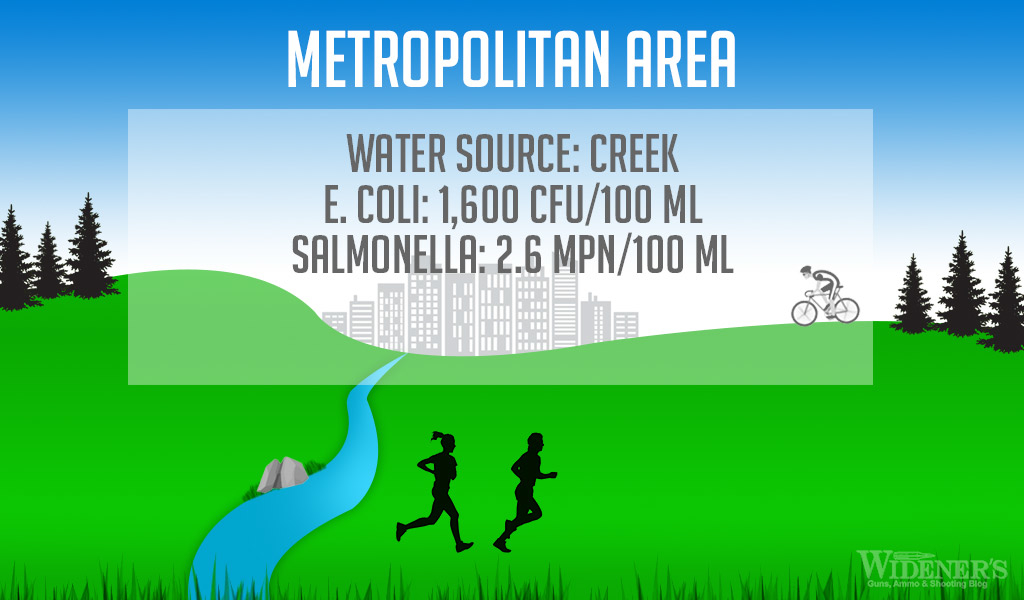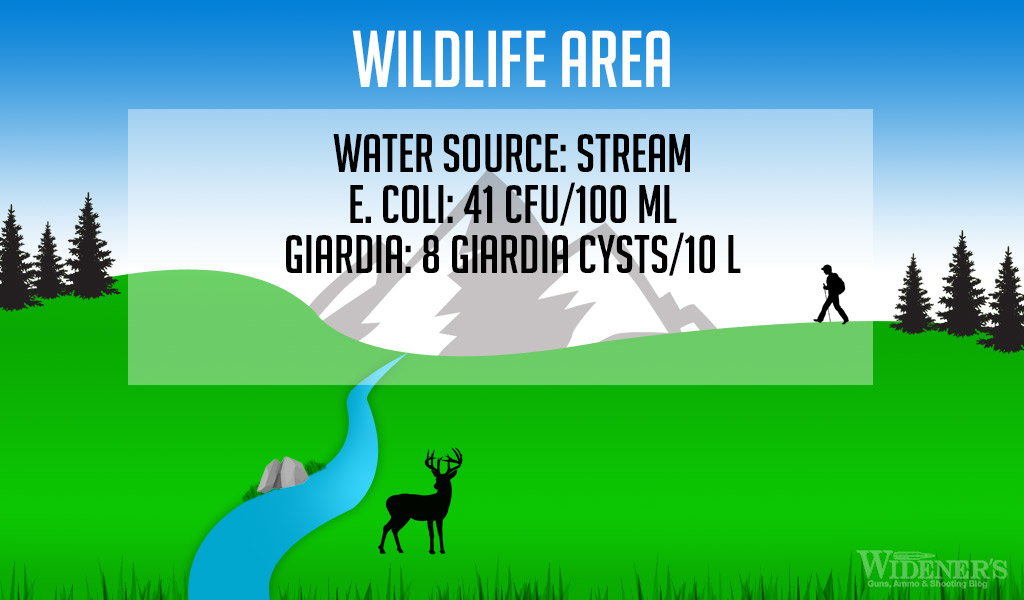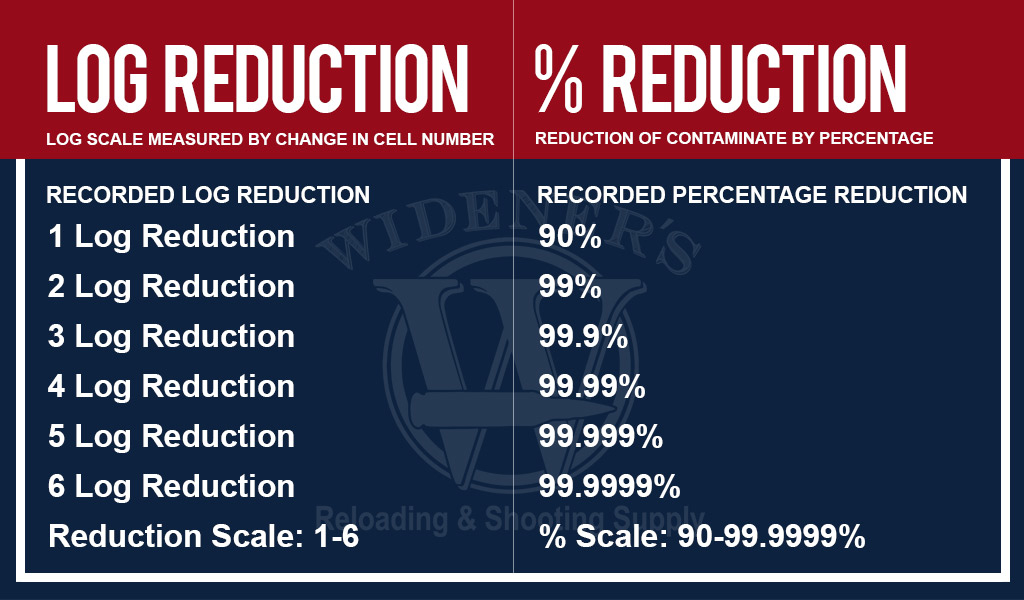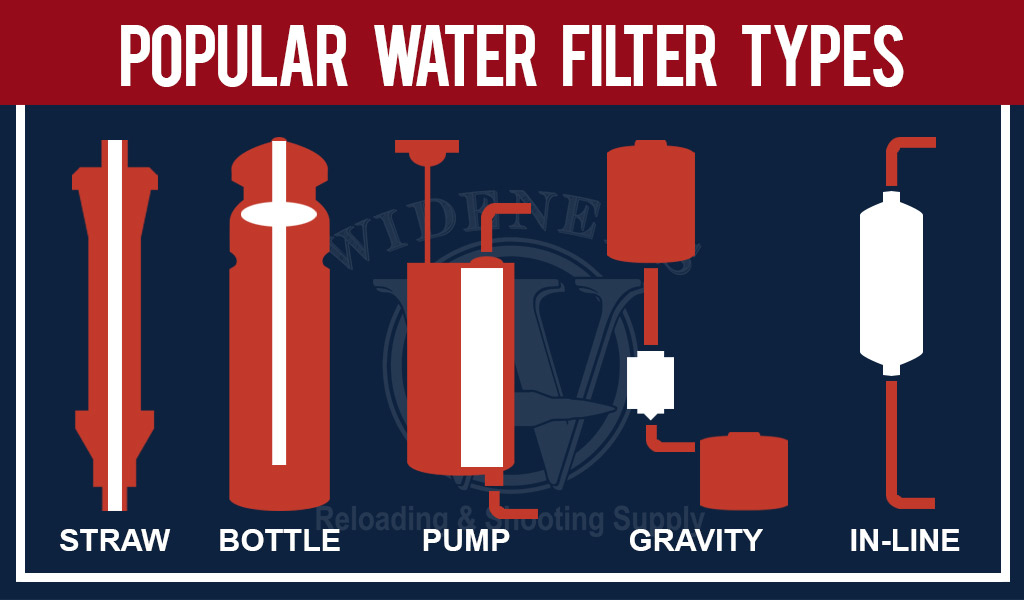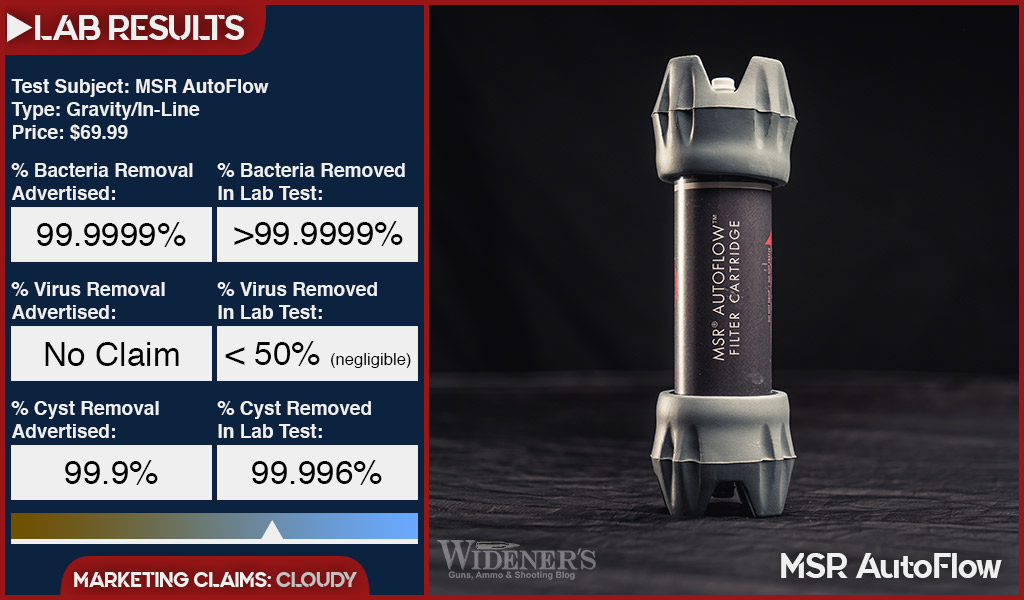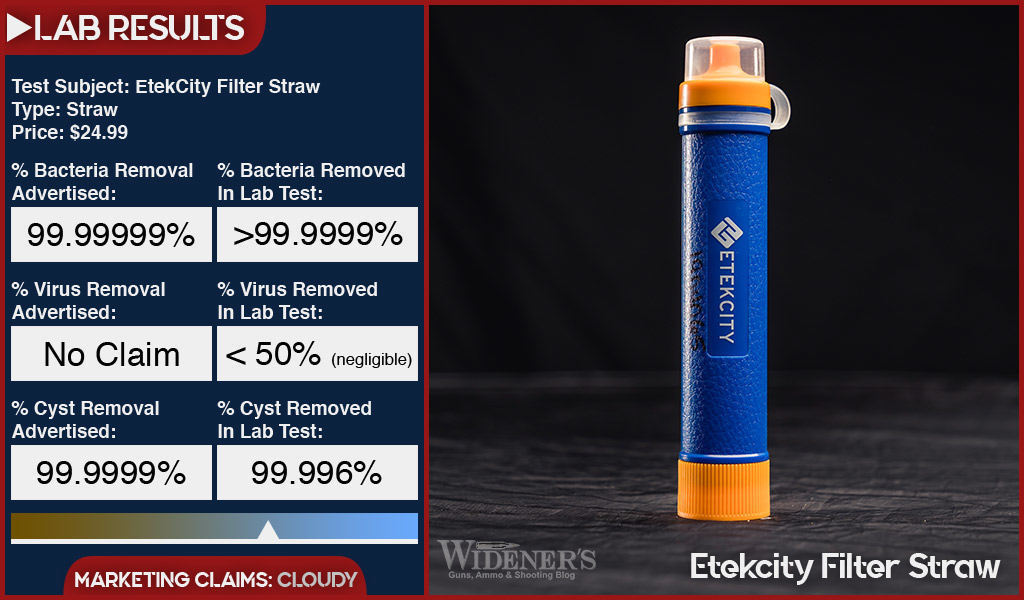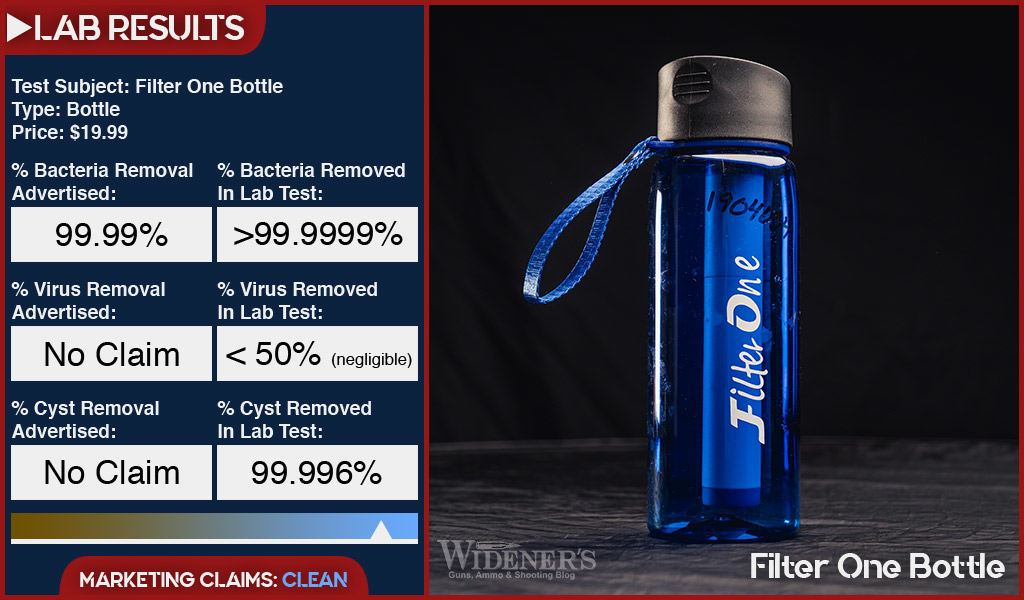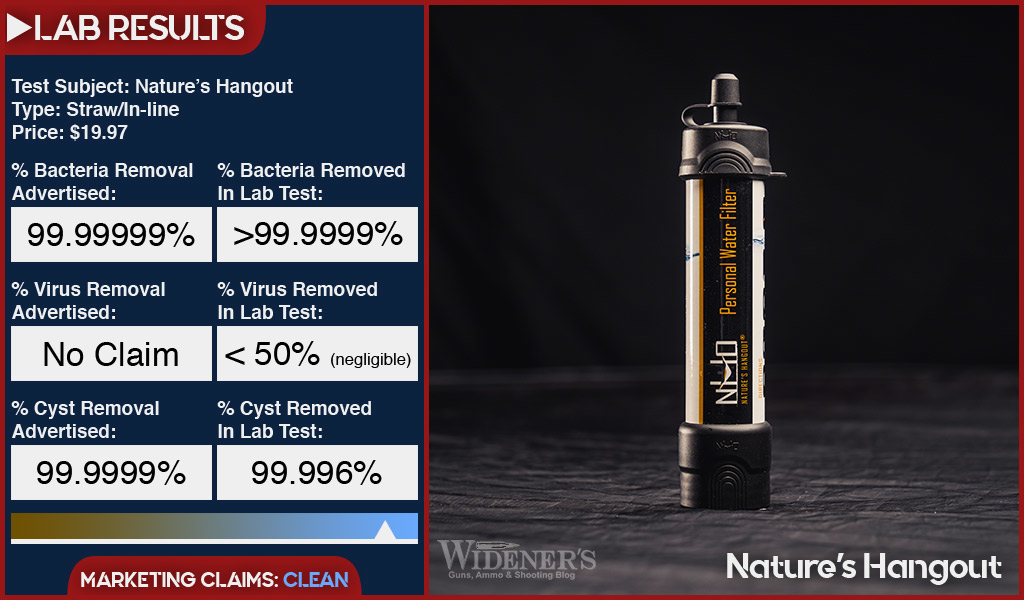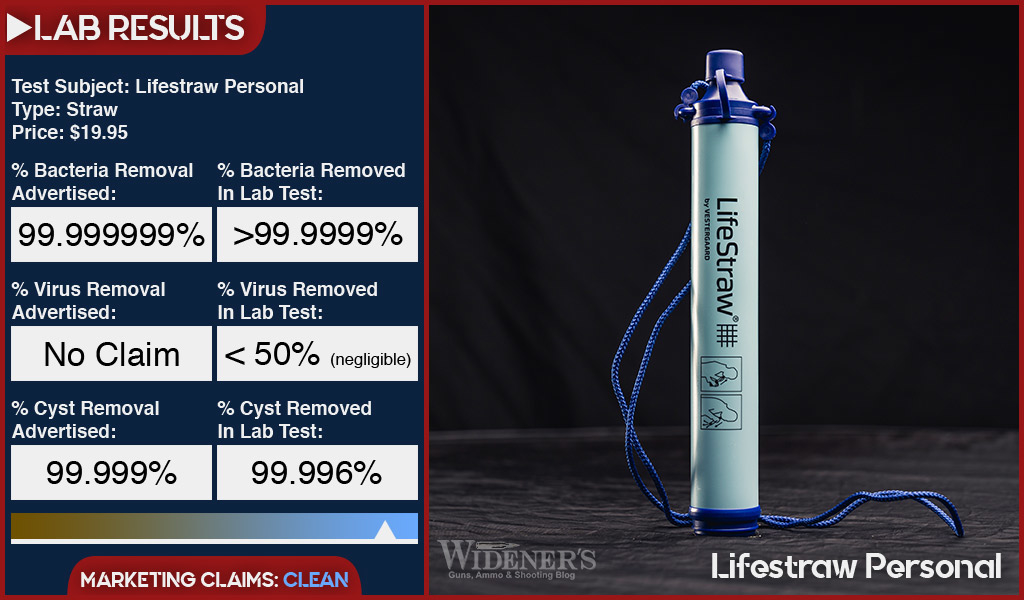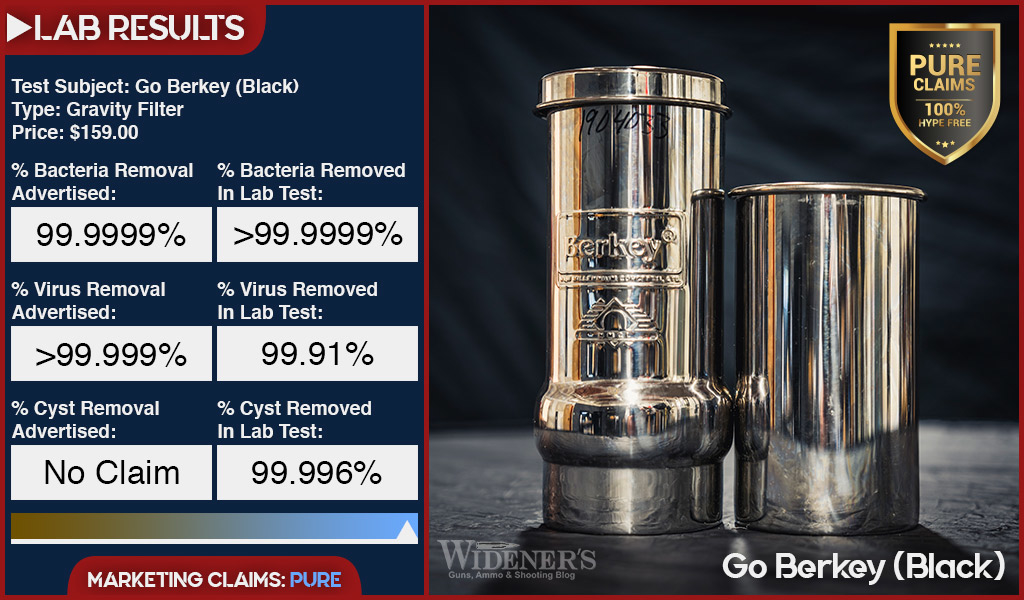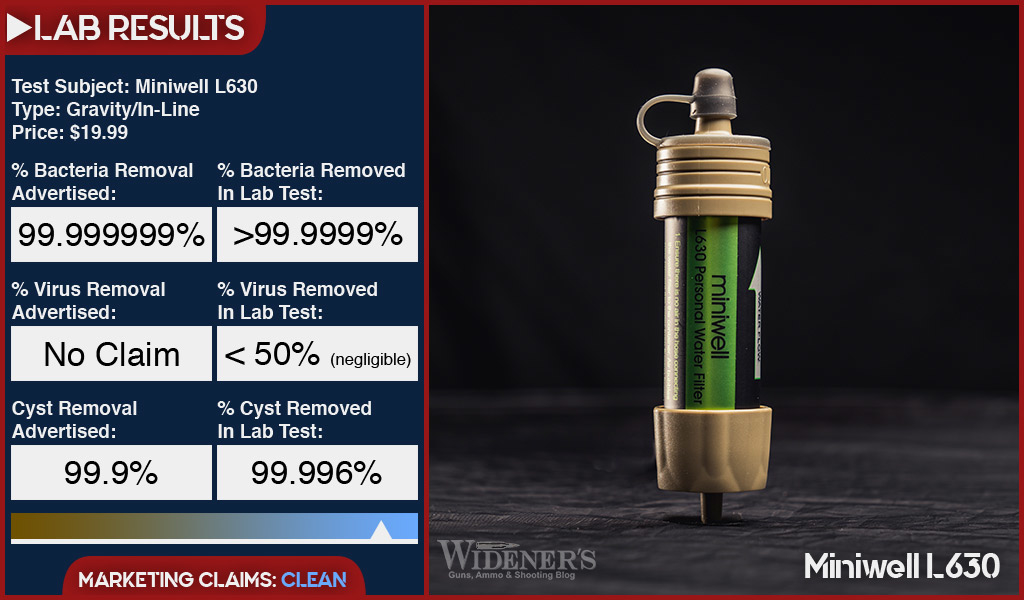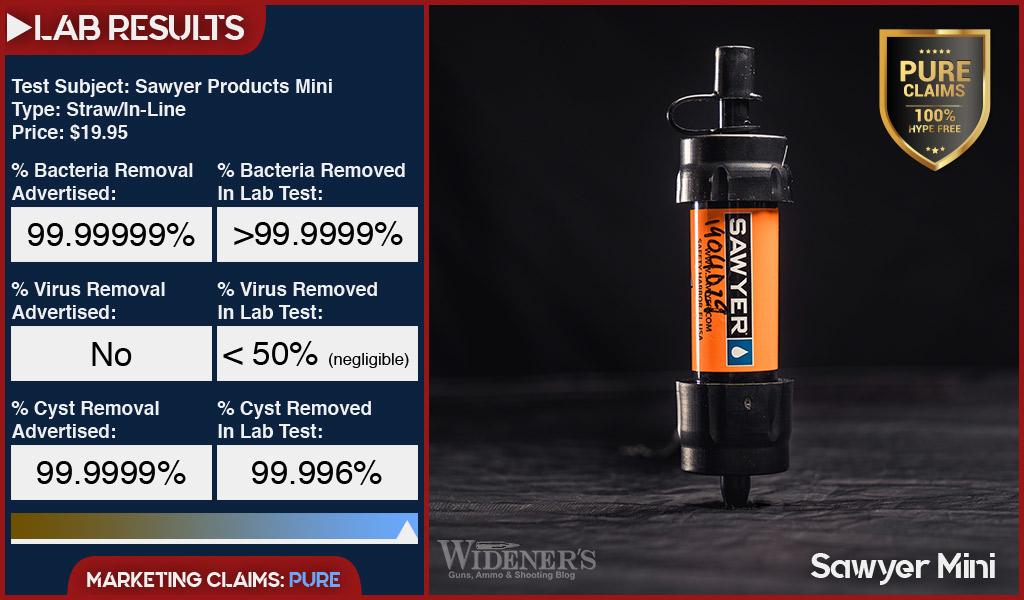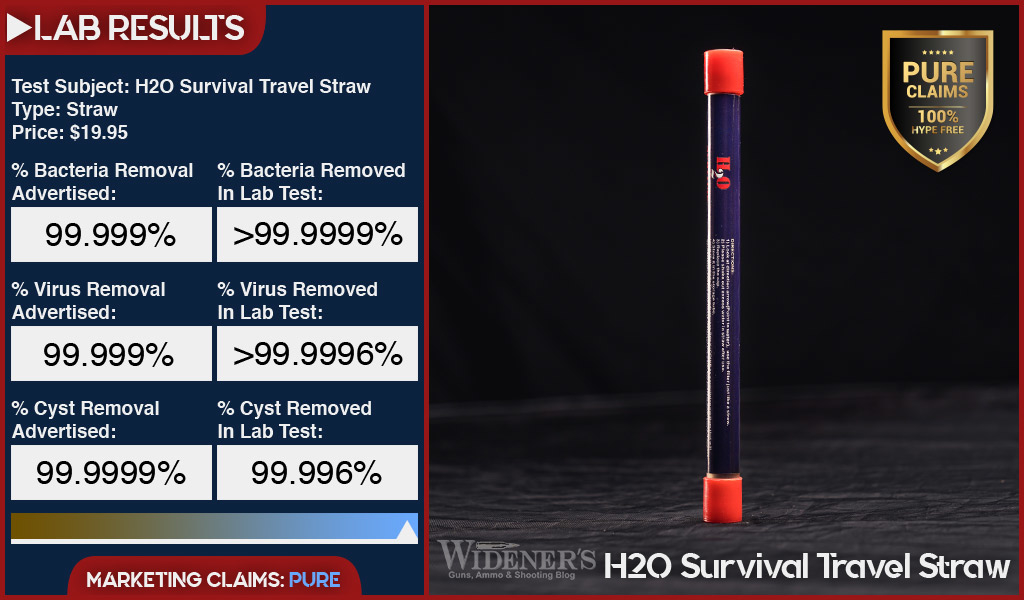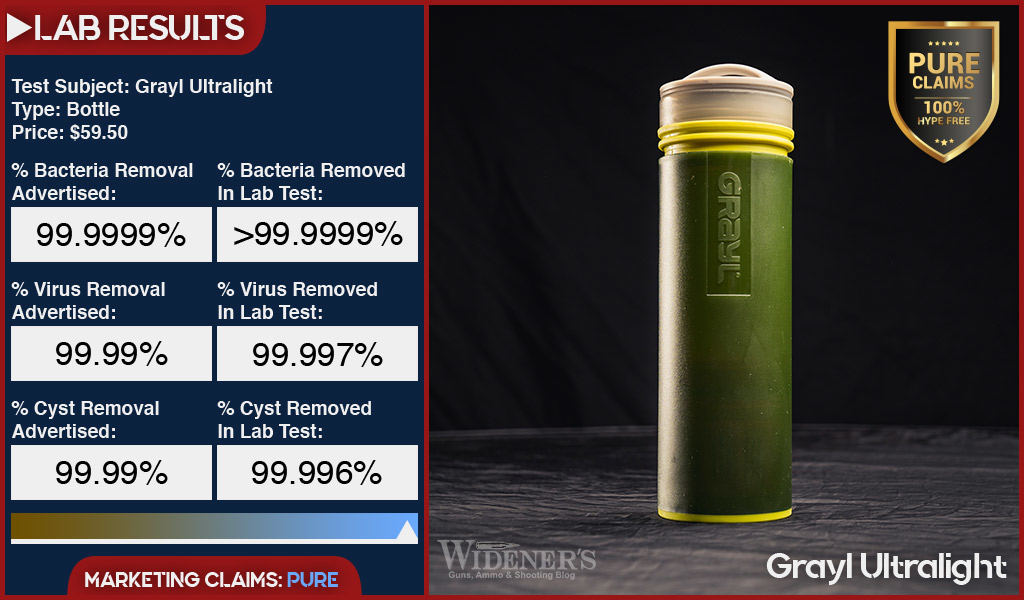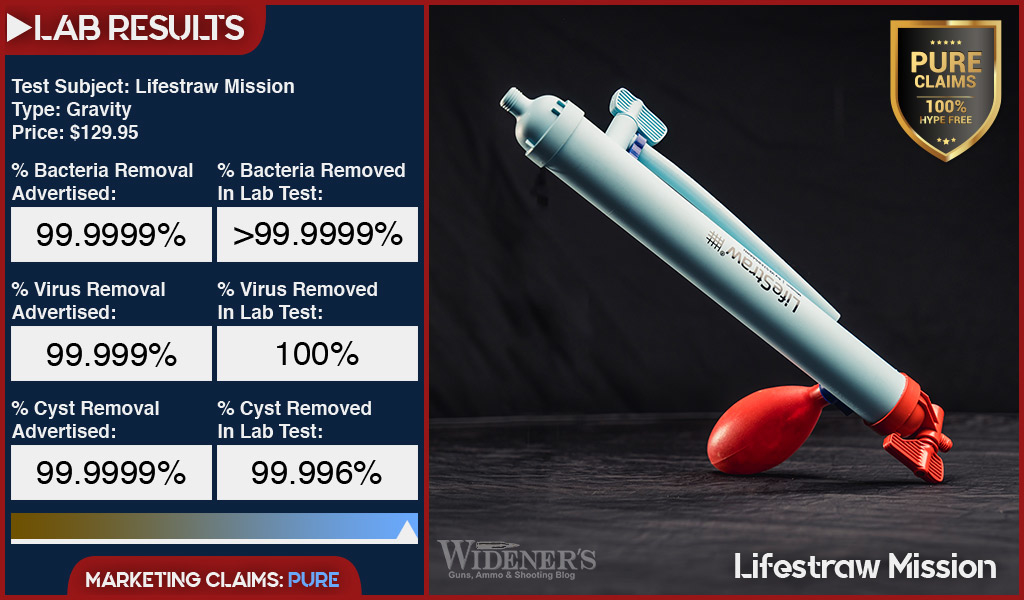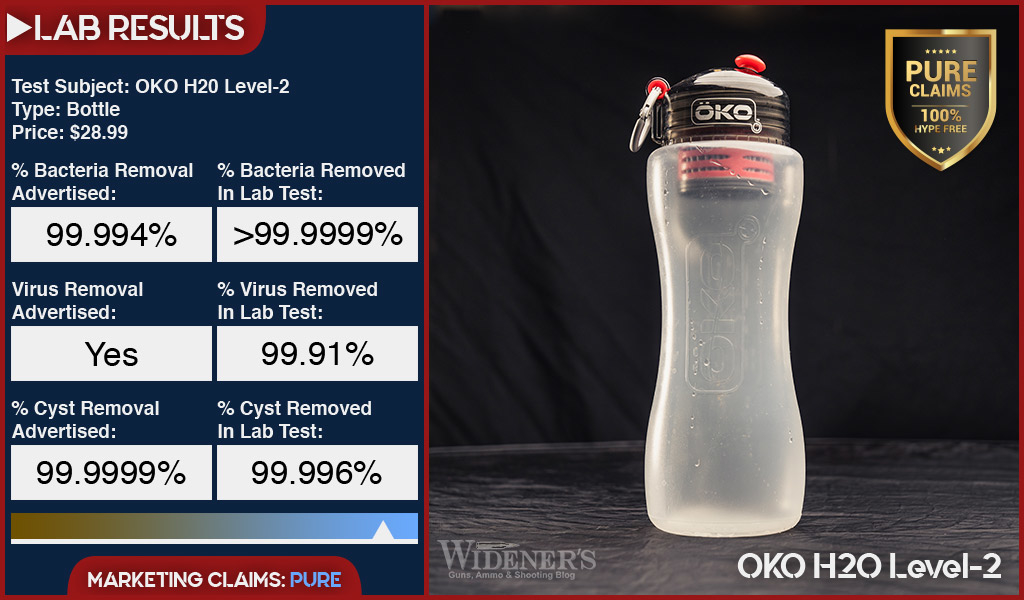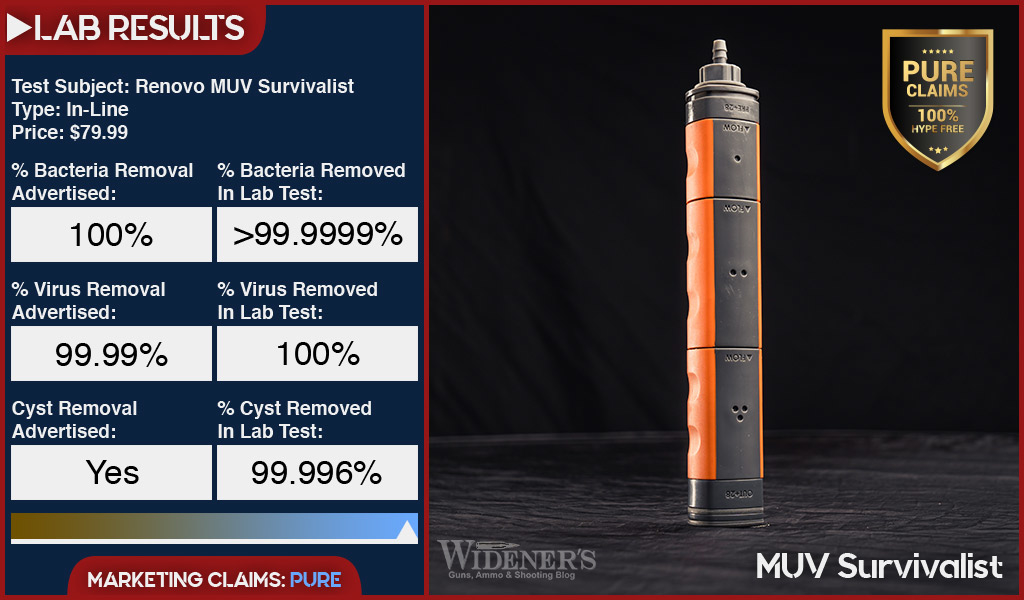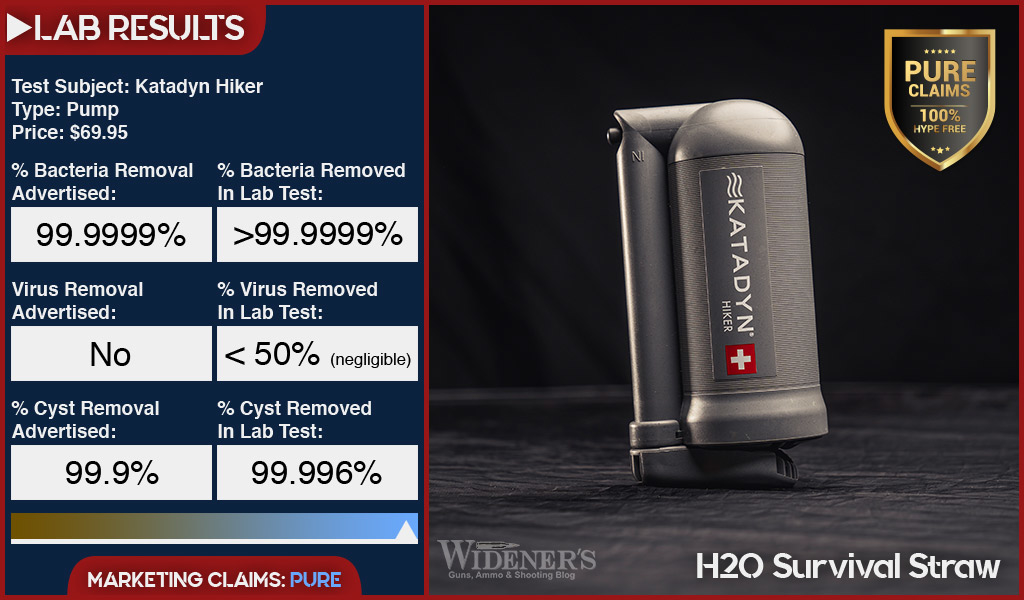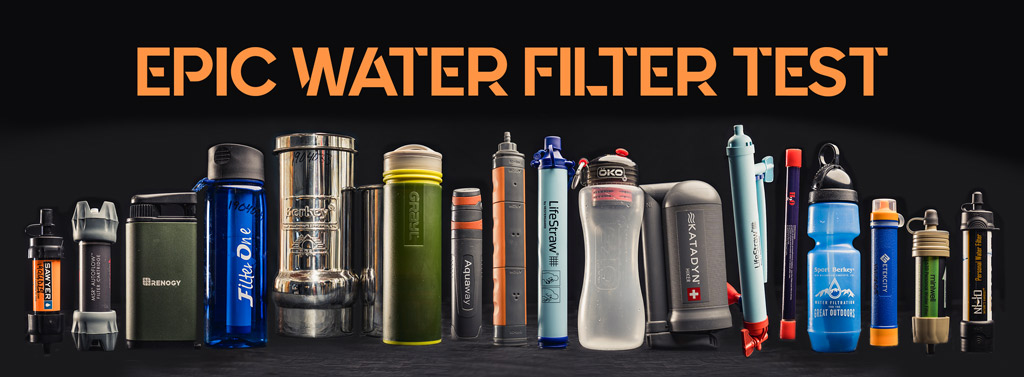
Few things are as personal as what you put up to your lips and drink into your body. You want to know what you are consuming is safe, reliable, and will hydrate your body to climb that next mountain or sustain you through an afternoon stroll. These facts are the driving force behind one of the most exhaustive tests of popular survival and backpacking water filters sold in the United States.
Did you know that there is no regulatory body that monitors water filter companies and their marketing practices? Consumers can read the claims and data that companies publish, but there’s no independent resource to filter out the legitimate from the hyperbole.
Among a mostly honest field of products, Wideners’ testing shines light on an industry tainted by a few bad players boasting exaggerated marketing claims, seemingly identical products sold under different brand names, and a wave of other shady practices.
“It’s sort of the wild west out there in the water filter industry,” Dr. George Lukasik, director of BCS Laboratories, an accredited water testing facility in Gainesville, Florida said.
To help navigate this frontier, we’ve put together all the information you need to find the best portable filter for your needs.
Our intention is that this guide will serve as a resource. Inside, you’ll find a ton of data and research from accredited health and water monitoring agencies. You’ll also find filter testing we commissioned through an independent accredited laboratory.
To jump straight to any section, use our Table of Contents below or watch the video for a summary of the project.
In This Water Filter Guide:
- Potential Water Contaminants
- Water Sample Tests – What’s In The Water?
- Water Treatment Methods – How Do Filters Work?
- What Are Filters Made Of?
- Water Filter Regulators and Regulations
- Purifiers vs. Filters
- Water Filter Test Results
- Picking the Best Water Filter
Potential Water Contaminants
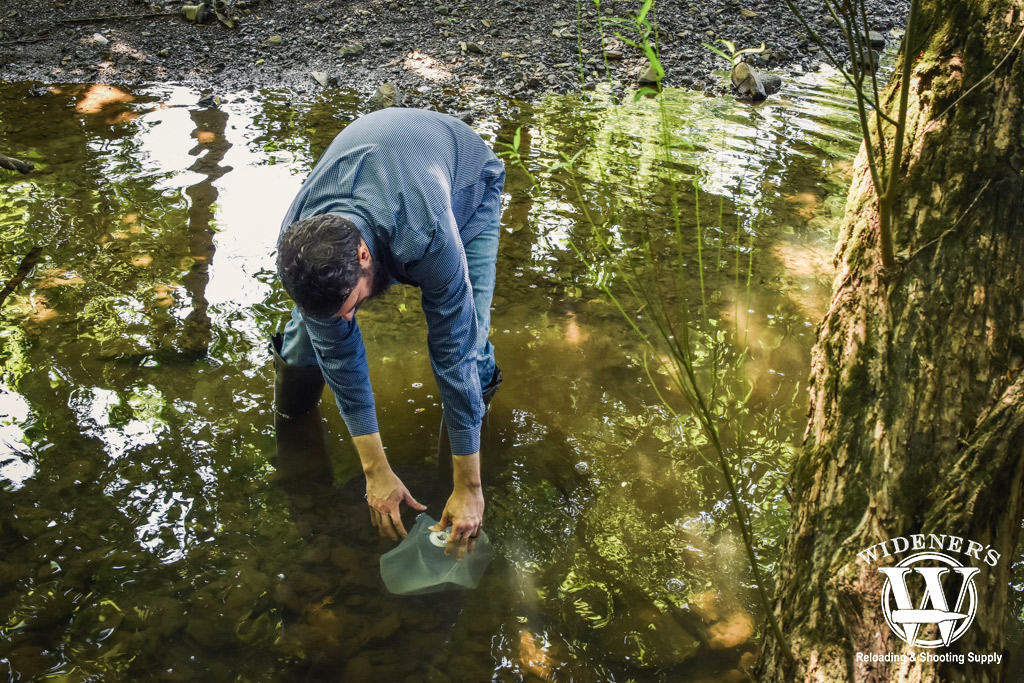
In cases of emergency or natural disaster, having access to clean drinking water is a must for human survival.
Quick Water Facts:
- A 2015 study found “nearly 25% of the global population is consuming fecally-contaminated water.” This is documented in a peer-reviewed journal associated with the National Center for Biotechnology Information.
- “Diarrhoeal disease alone amounts to an estimated 3.6% of the total DAILY global burden of disease and is responsible for the deaths of 1.5 million people every year,” according to the World Health Organization.
- Pathogenic microbes cause waterborne diseases. These microbes include bacteria, protozoa, and viruses. Some of the most common symptoms from waterborne illnesses are diarrhea and vomiting.
What Contaminates Water?
If you live in the United States, chances are, the water that comes out of your sink at home is safe to drink. In a system-collapse or survival situation, you should be concerned about potential contaminants. Untreated drinking water can harbor dangerous substances that cause long-term illness and even death.
There are four broad categories of drinking water contaminants:
- Biological
- Chemical
- Radiological
- Physical
While not as large a problem in first world countries, symptoms of waterborne diseases are quite common worldwide. The most common symptoms (diarrhea and vomiting) lead to 1.5 million deaths every year, according to the World Health Organization.
You’ve probably seen the news reports about the parasite cryptosporidium in public pools or at beaches. In those cases, odds are good the problem started with contaminated fecal matter that made its way into the water system through waterborne pathogens.
Of the biological contaminants you need to be concerned about, there are three main pathogenic microbes that cause these waterborne diseases: bacteria, viruses, and cysts/protozoa. These microbes are what water filters aim to remove from your drinking water.
Biological Contaminants
Bacteria
Bacteria are single-celled organisms; some can be helpful to humans and others can cause disease. They can range in size from 1 to 10 microns in length and 0.2 to 1 micron in width.
Waterborne bacteria that can cause diseases and their symptoms include:
E. coli
Most E. coli are harmless, but certain strains can cause disease. Symptoms include diarrhea, vomiting, and abdominal cramps. Death is even possible in immunocompromised individuals, young children, and the elderly due to dehydration, according to the Centers for Disease Control.
Shigella
Shigella can cause dysentery (an inflammatory disease of the intestine). Symptoms of Shigella include severe diarrhea and abdominal pains; can include blood and/or mucus in feces and vomit.
Salmonella
Salmonella leads to salmonellosis. Symptoms include diarrhea (sometimes bloody), fever, stomach cramps, nausea, vomiting, and headache.
Legionella
Legionella can lead to Legionellosis, otherwise known by its two types: Legionnaires’ disease and Pontiac fever. Symptoms can include fever, chills, pneumonia, muscle aches, diarrhea, vomiting, and more.
Campylobacter Jejuni
Campylobacter causes Campylobacteriosis and its symptoms include diarrhea (sometimes bloody), fever, abdominal cramps, nausea, and vomiting.
Viruses
At 0.004 to 0.1 microns, viruses are the smallest of waterborne, disease-causing microbes. They’re also the toughest to filter out because of their small size, according to the Environmental Protection Agency.
Viruses are made up of protein and nucleic acids. They can only reproduce within living cells. Some common waterborne viruses include Hepatitis A, rotavirus, and poliovirus.
Hepatitis A
Hepatitis A is disease of the liver. It’s preventable by vaccine and acute symptoms include fatigue, fever, abdominal pain, nausea, diarrhea, weight loss, jaundice, and depression.
Rotavirus
Rotavirus causes inflammation of the stomach and intestines. Its symptoms include diarrhea, vomiting, fever, and abdominal pain. Infants and young children are most likely to contract rotavirus, especially if they are not vaccinated.
Poliovirus
Poliovirus can lead to polio for humans unvaccinated against it. Polio’s symptoms include sore throat, fever, tiredness, nausea, headache, and stomach pain. A small proportion of infected people will develop meningitis and paralysis. This has the potential to lead to permanent disability and death.
Cysts/Protozoa
Protozoa are microscopic, one-celled organisms that are able to multiply in humans. Protozoa can be transmitted through ingesting food or water that is contaminated with fecal matter from an infected person.
Protozoa that may be present in water include Giardia and Cryptosporidium.
Cysts are the dormant form of protozoa. Cysts/Protozoa are relatively large compared to bacteria and viruses, typically with a diameter of 2 to 50 microns.
Giardia
Giardia is a parasite that causes giardiasis, a diarrheal disease. Giardia has an outer shell that protects it, allowing it to survive outside of the body for long periods of time and resist chlorine disinfection. Its symptoms include diarrhea, gas, stomach cramps, nausea, vomiting, and dehydration.
Cryptosporidium
Cryptosporidium is a parasite that causes cryptosporidiosis, a diarrheal disease. Similar to Giardia, it has an outer shell that protects it so that it can survive outside of the body for long periods of time and makes it tolerant to chlorine disinfection. Crypto symptoms include watery diarrhea, stomach cramps or pain, dehydration, nausea, vomiting, fever, and weight loss.
Other – Bacteria, cysts/protozoa, and viruses are examples of biological contaminants found in water, but there are other types of contaminants to be concerned about.
Chemical
Chemical contaminants can be naturally occurring or man-made compounds or elements. Common chemical contaminants include nitrogen, lead, oil, industrial runoff, bleach, salts, pesticides, metals, toxins produced by bacteria, and human or animal drugs.
Radiological
Radiological contaminants include cesium, plutonium, and uranium. These are chemical elements that can emit ionizing radiation.
Physical
Physical contaminants include things like sediment, silt and dirt that can not only clog up your filter but lead to health problems as well.
Water Sample Tests
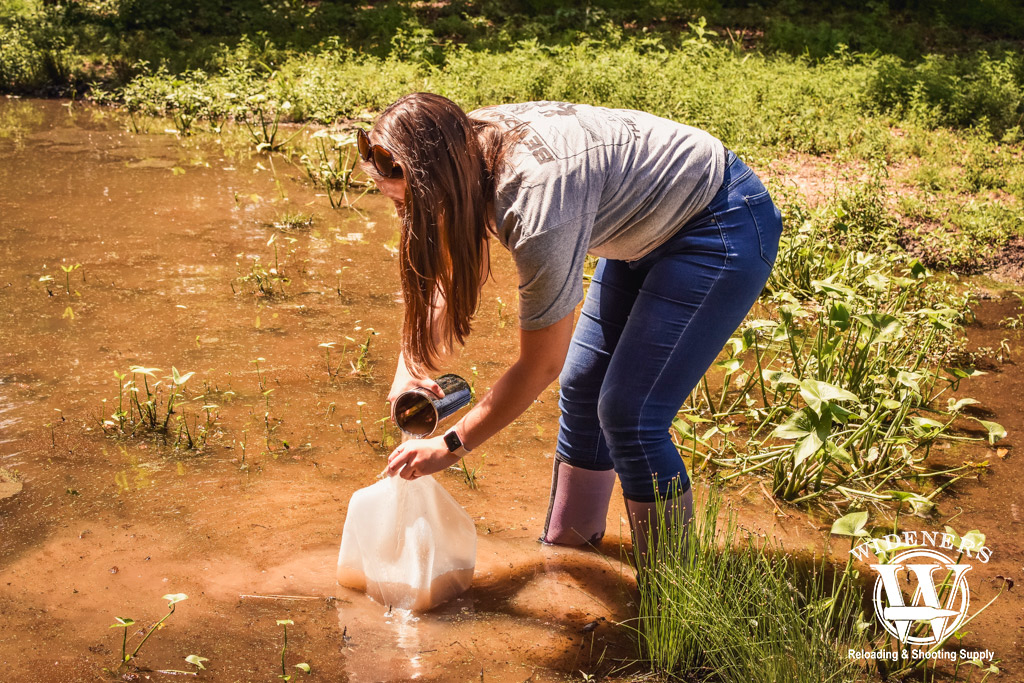
Water filters work by using microscopic pores to filter out contaminants like bacteria, viruses, and cysts.
We wanted to find what contaminants could be in water sources you might drink from while either on a backpacking trip or in a survival situation. We collected 2.5 gallons of water from three separate water sources to send to an independent laboratory for testing.
Our team collected water from three different areas:
- An urban creek running in a metropolitan area
- A stream running through a state managed wildlife area
- An agricultural area’s pond
While catastrophic flooding could make the water even dirtier, we discovered just how contaminated a stream flowing through the downtown area of a big city would be.
Most people aren’t going to drink water from a stream or river flowing through the city, even with a filter. But in a major environmental crisis, it may be your only source of water.
Backpackers and hikers regularly drink water from streams and rivers deep in the wilderness. A relatively remote wildlife area serves as a good sample for this type of filter user.
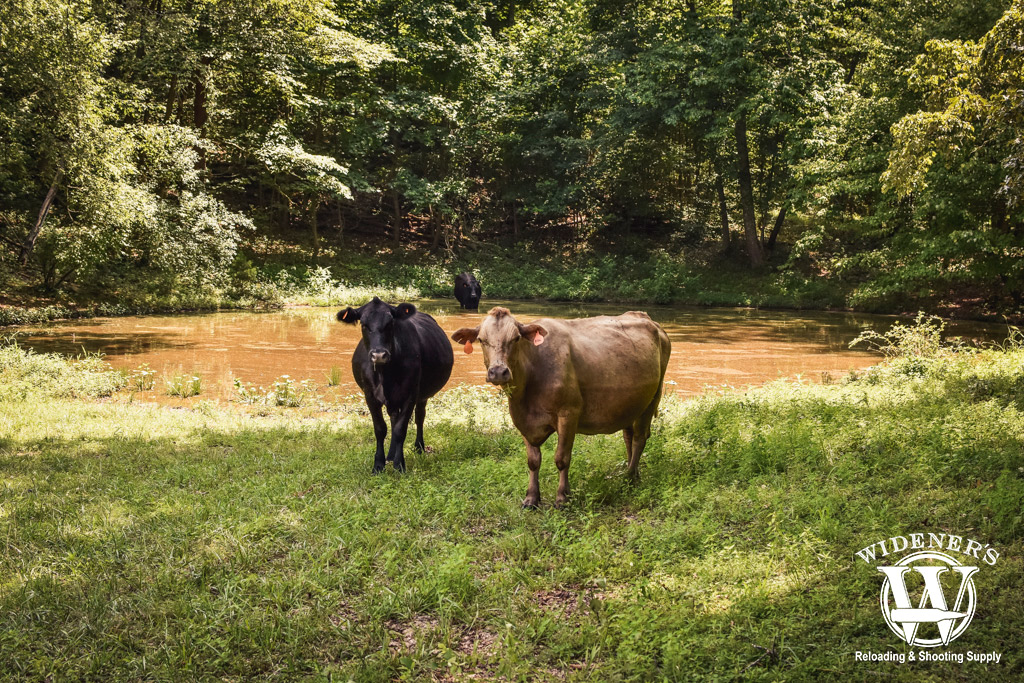
Not all contaminants are man-made, wild animals and livestock also contribute to water pollution.
The last water source we tested was a pond located in a cow pasture. The cattle have free access to the pond. In fact, you can often find them cooling off in it on a hot day.
In a bug out or survival situation, most people know they should try to avoid standing water. However, in an emergency it may be the only source of water available. So, as a “worst-case” type scenario we thought it was worth a test to see what was in it.
To run these tests, we sent 2.5 gallons of water from each source to Biological Consulting Services of North Florida. The lab analyzed the samples for the following contaminants: E. coli, Legionella, Cryptosporidium, Giardia, Salmonella, and Shigella.
Our Water Test Results:
Metropolitan Area
The creek we collected a water sample from is 18 miles long. It winds through a metropolitan area, connecting with four paved walking trails until it discharges into a major river. Because it runs through a city, pollution is a concern. At the time of water collection, the outside temperature was 87 degrees Fahrenheit and we were at an altitude of 843 feet.
What Was In The Water:
- E. coli: 1,600 CFU/100 mL
- Salmonella: 2.6 MPN/100 mL
The amount of E. coli the lab found is enough to be considered well outside the acceptable range for swimming – let alone drinking.
Of course, any water you drink should have no E. coli present after treatment. At designated swimming beaches, E. coli levels should not exceed 88 per 100 mL in any one sample.
E. coli levels at recreational water that are not designated beaches should not have more than 406 CFU per 100 mL in any one sample.
Our testing also found Salmonella in the stream. Most people know of Salmonella because of its relevance in food contamination, but you can also transmit it through water ingestion.
Based on what the lab tells us about this water, it’s obvious this water source isn’t one you’d want to pull raw water from to drink.
Wildlife Management Area
The second location we retrieved water from is a stream running through a 140,000+ acre state wildlife management area. At the time of collection, the outside temperature was 86 degrees Fahrenheit and the collection point was at an elevation of 1,355 feet.
What Was In The Water:
- E. coli: 41 CFU/100 mL
- Giardia: 8 Giardia Cysts/10 L
Our testing found the presence of E. coli, but in a much smaller amount than the metropolitan water source. The amount of E. coli present, 41 CFU/100 mL, is within acceptable levels for recreational water (under 406 CFU/100 mL). However, drinking this water without proper treatment has a chance of making you sick if the E. coli present are pathogenic strains.
We also found some Giardia cysts in the water. Many people like to think that the water deep in the wilderness is going to be pristine. It is important to remember that wild animal fecal matter can easily make it into your water source and make you sick.
Farming Area
Our final water sample came from a pond in a cow pasture on a private farm. The source of the water is unknown, but this pond is likely spring-fed. The cattle have free access to this pond as their lone water source. They can be found cooling off in it on hot days.
At the time we collected a sample from the pond, it was 94 degrees Fahrenheit outside and we were at an elevation of 1,161 feet.
What Was In The Water:
- E. coli: 400 CFU/100 mL
- Giardia: 1 Giardia Cyst/10 L
Just like the water sampled in the wildlife area, we found E. coli and Giardia. We found higher E. coli levels at it than in the wildlife area stream. However, the metropolitan area was by far the worst offender for E. coli, outpacing even this agricultural pond. The lab found one Giardia cyst in the 10 L sampled.
The presence of these bacteria in the farm’s pond is not surprising. Both E. coli and Giardia can come from cow manure. With cattle freely using this pond to drink and cool off, there’s no doubt they use it as their toilet as well.
Water Treatment Methods – How Do Filters Work?
How Do Water Filters Work?
Water filters use microscopic pores to catch contaminants like bacteria and protozoa, as well as other debris/sediment. Some use activated carbon to reduce unpleasant tastes and reduce other contaminants like pesticides and industrial chemicals.
What Are Microns?
We measure the pores that catch contaminants in units called microns.
A micron, which is an abbreviation for micrometer, is one one millionth of one meter (1/1,000,000 meters). You’ll often see advertising that mentions how many microns a water filter protects against. This can be an important aspect of determining the water filter you need.
- 1 inch = 25,400 microns
- Width of a single hair = 75 microns
- Human red blood cell = 5 microns
- Protozoa/Cysts = 2 to 50 microns
- Bacteria = 1 to 10 microns in length and 0.2 to 1 micron in width
- Viruses = 0.004 to 0.1 microns
Absolute Pore Size vs. Nominal Pore Size
The CDC has noted that there is a difference between “absolute pore size” and “nominal pore size.” A filter that claims “nominal X micron pore size” may still let through 20% to 30% of particles that pore size. A filter that claims “absolute X micron pore size” performs more consistently.
What is Log Reduction?
You will occasionally see contaminant reduction referred to in log reduction. This is a way to express large numbers in a simple way using the logarithmic scale. As an example, if a company claims its product filters out bacteria to a Log 4, it means it filters out 99.99% of bacteria.
What is Membrane Filtration and How Does It Work?
Membrane filtration is the use of a thin layer of semi-permeable material (the membrane) to remove bacteria, microorganisms, particulates, and natural organic material when water is pushed through it.
Microfiltration, ultrafiltration, nanofiltration, and reverse osmosis are membrane filtration processes explained below.
Microfiltration
0.5 to 5 microns – Effective at eliminating bacteria; can be a good pretreatment stage before ultrafiltration, nanofitration, or reverse osmosis because it reduces the possibility of fouling in those steps.
Ultrafiltration
0.005 to 0.5 microns – Effective pretreatment for nanofiltration or reverse osmosis.
Nanofiltration
0.0007 to 0.005 microns – Nanofiltration requires much more pressure due to smaller pore size and can foul quicker.
Reverse Osmosis
Typically .0001 micron, according to the CDC. In reverse osmosis, pressure is used to counteract the osmotic pressure. This pushes water through a membrane, removing ions, salt, and other particles.
What’s Your Filter Made Of?
There are different materials that make up most common water filters.
Filter membranes are made of:
- Hollow fiber
- Fiberglass
- Ceramic material
- Stainless steel
- Synthetic polymer
- Pre-filter – An accessory used to remove large particles before they reach the filter.
- Activated carbon – Activated carbon is used to adsorb natural organic compounds, taste and odor compounds, as well as synthetic organic chemicals. Granular activated carbon and powdered activated carbon are the two main types filters use. They are highly porous materials that provide large surface areas to adsorb contaminants. Carbon filters are not designed to remove all disease-causing organisms. They do, however, effectively improve taste and can reduce lead. Activated carbon is commonly used in conjunction with other types of filtration.
- Coal, coconut shells, peat, and petroleum based residues are all sources of activated carbon. Because coconut activated carbon predominantly has pores sized in the micro pore range (<4 nm), has a tight structure and good mechanical strength, and is a renewable source of carbon, it is not uncommon to see it used in water filters.
- Adsorption media – Made of elements that have a chemical reaction with the contaminants in water. The element creates an attraction with the contaminant which then sticks to the media rather than passing through. The adsorptive media can quickly lose its ability to attract contaminants with high usage.
Other Water Treatment Methods
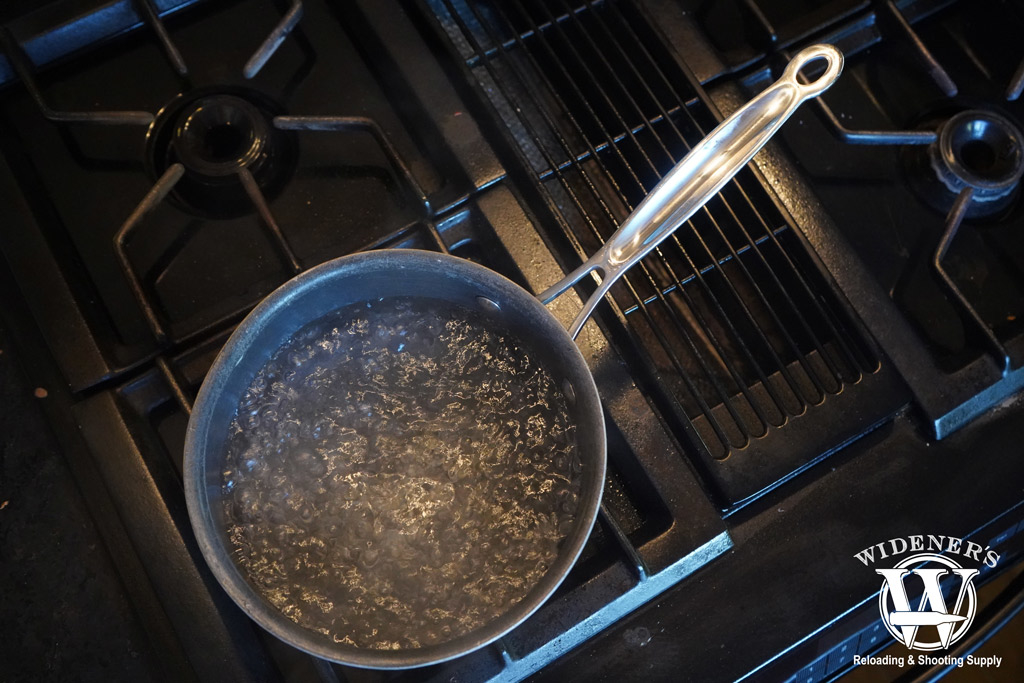
Did you know that boiling water for one minute will kill the majority of disease-causing organisms?
Distillation
Distillers remove or kill chemical contaminants and microbes by heating the water to a boil, then collecting the water vapor as it condenses. This method is effective against almost all impurities in water, including nitrates, bacteria, sodium, hardness, dissolved solids, most organic compounds, and lead.
Distillation is not always effective against contaminants that easily turn into gases, like radon and gasoline components. Distilled water may taste flat because natural minerals and dissolved oxygen has been removed.
While distillation is an effective water treatment method, it is impractical for those needing a portable water treatment method because it requires the proper equipment.
Boiling
Bringing water to a boil for one minute (or three minutes at elevations above 6,500 ft) will kill disease-causing organisms like bacteria, protozoa, and viruses. If the water is cloudy, it must be filtered through a clean shirt, coffee filter, or paper towel before boiling.
Cons of boiling: uses a lot of fuel, can be inconvenient, you have to wait for hot water to cool before drinking, you have to filter out solid particles beforehand.
Iodine Based Disinfection
Iodine is used for water disinfection because of its antimicrobial properties. While iodine is effective against bacteria and viruses, it is not effective against Cryptosporidium.
Long-term, excessive iodine intake can result in health issues like an enlarged thyroid, known as goiter. Healthy individuals with no known thyroid conditions or iodine sensitivities can safely ingest iodine concentrations for short periods of time (3 months or less).
- Iodine Solutions – A solution or tablet containing iodine is added to the water to disinfect it.
- Iodine Resins – Iodine resins are incorporated into various filter designs. They work by transferring iodine to microorganisms that come into contact with the resin, leaving little iodine in the water.
Iodine tablets are lightweight and easy to use, but require at least a 30 minute delay before drinking and can have an unpleasant aftertaste.
Other Chemicals
- Chlorination – Chlorine-based gas, solution, or tablets are added to water to disinfect and control microorganisms. It can leave the water with a strange taste and smell but can often be remedied with taste-neutralizer tablets.
Chlorine is effective against viruses and bacteria, but does not treat Cryptosporidium.
Ultraviolet light
Ultraviolet (UV) disinfection kills bacteria, viruses, fungi, protozoans, and cysts by exposing water to a light at the correct wavelength to kill the microbes. Its effectiveness is dependent on the strength and intensity of the UV light, the length of time the light shines on the water, and the quantity of particles in the water.
UV disinfection may not work on cloudy water because small particles may block germs from the light.
Water Filter Regulations
Safe drinking water is clearly important, and having a water filter fail can be fatal. Surely, then, there is a government agency that has oversight of these filters, right? Well, not really.
As Dr. George Lukasik, the Director of BCS Laboratories, said, the water filter industry is like the wild west. There is very little oversight in the industry and companies can make misleading or false claims with little chance of retribution.
“With respect to false claims, there is not a government agency that regulates, outside of perhaps a State Attorney’s office,” according to a representative from the NSF International, an independent public health and safety organization formerly known as The National Sanitation Foundation.
There are very specific instances when a filter company must register with the EPA, as well as register voluntarily through the NSF.
EPA Regulations on Water Filters
The EPA registers any product that uses a material or agent that kills or slows the growth of germs (bacteriostatic agents) under the Federal Insecticide, Fungicide, and Rodenticide Act.
They do this because consumers cannot independently verify germ-related claims. If a product has an EPA registration number, it means the EPA has verified all bacteriostatic claims, though the EPA does not perform any tests. This registration is not meant as a guide or an endorsement for consumers to use, but merely an administrative registration.
Since most of the filters we find for survival and backpacking don’t include a chemical for water treatment, they don’t fall under this classification. In other words, don’t expect to find an EPA registration number on your water filter that you use for backcountry hikes.
Purifiers vs. Filters
Purifiers and filters are technically different, although many people use the terms interchangeably for the purpose of marketing. Water purifiers must remove, kill, or inactivate all types of disease causing organisms from the water, including viruses, according to the EPA.
Filters, on the other hand, do not have to protect against viruses.
NSF Standards
The NSF has created voluntary national standards for minimal requirements for safety and performance of residential water treatment.
You’ll occasionally see one or more of these standards referenced by a water filter company. It is important to note that just because a product has an NSF/ANSI certification, it does not mean that it will reduce all possible contaminants.
You can view the entire list of certifications here.
Some of the more common certifications you’ll see on portable water filters include:
NSF/ANSI 42
Filters are certified to reduce aesthetic impurities such as chlorine and taste/odor. These can be point-of-use (under the sink, water pitcher, etc.) or point-of-entry (whole house) treatment systems.
NSF/ANSI 53
Filters are certified to reduce a contaminant with a health effect. Health effects are set in this standard as regulated by the U.S. Environmental Protection Agency (EPA) and Health Canada. Both standards 42 and 53 cover adsorption/filtration, which is a process that occurs when liquid, gas, or dissolved/suspended matter adheres to the surface or pores of, an adsorbent media. Carbon filters are an example of this type of product.
NSF/ANSI 55
Ultraviolet treatment systems use ultraviolet light to inactivate or kill bacteria, viruses, and cysts in contaminated water (Class A systems) or to reduce the amount of non-disease causing bacteria in disinfected drinking water (Class B).
NSF/ANSI 58
Reverse osmosis systems incorporate a process that uses reverse pressure to force water through a semipermeable membrane. Most reverse osmosis systems incorporate one or more additional filters on either side of the membrane. These systems reduce contaminants that are regulated by Health Canada and EPA.
NSF/ANSI 62
Distillation systems heat water to the boiling point, and then collect the water vapor as it condenses, leaving behind contaminants such as heavy metals. Some contaminants that convert readily into gases, such as volatile organic chemicals, can carry over with the water vapor.
NSF/ANSI 244
The filters covered by this standard are intended for use only on public water supplies that have been treated or that are determined to be microbiologically safe. These filters are only intended for protection against intermittent microbiological contamination of otherwise safe drinking water. For example, prior to the issuance of a boil water advisory, you can be assured that your filtration system is protecting you from intermittent microbiological contamination. The standard also includes material safety and structural integrity, similar to other NSF/ANSI drinking water treatment unit standards. Manufacturers can claim bacteria, virus, and cyst reduction for their filtration system.
NSF P231
Microbiological water purifiers are certified for health and sanitation based on the recommendations of the EPA’s Task Force Report, Guide Standard and Protocol for Testing Microbiological Water Purifiers (1987) (Annex B).
NSF P248
The NSF International Protocol P248 helps protect the health of Service Members that use water purifiers on planned missions, in disaster/emergency situations, or where there is limited access to a treated water supply. This protocol covers small individual water purifiers (IWPs) and systems known as small unit water purifiers, collectively known as SWPs (small water purifiers).
Which Certification is Best?
You will often see NSF/ANSI 42 and 53 referenced by filter companies, but these standards are not adequate for a survival filter. These standards largely center on taste and aesthetic effects. These standards are geared towards residential water filters for tap water.
For a backcountry water filter, you should look for NSF/ANSI P231, though NSF P248 is even better.
Be aware that some companies advertise that their filter meets a certain certification for a specific contaminant. This can be a bit misleading. For example, a company may claim it “meets NSF P248 for bacteria”, but that filter might not remove viruses like the complete P248 certification calls for. In some ways, it feels they’re trying to confuse customers by claiming a certification they only meet a portion of the requirements for.
Types of Portable Water Filters and Purifiers
Straw Filters
As its name says, this filter is shaped like a straw. This filter uses the suction from the user to move water through the integral filter.
Pros: Water treatment is easy and quick; usually lightweight and easy to toss in a backpack or bug out bag.
Cons: Inefficient for more than one person; collection from a water source can be difficult; filtered water is only available at the source.
Bottle Filter
A bottle filter can be a filter straw inside a bottle or some other type of filter integrated into a bottle. These are quite common and can be effective.
Pros: Water treatment is quick and easy; you can collect and store water to use later.
Con: Water quantity is limited to the size of the bottle.
Pump Filter
The user works a pump that forces water (usually from the water source directly via a small hose) through the filter and into the user’s chosen container/reservoir.
Pros: Easy to collect water from shallow sources with the use of a hose; user has control over precisely how much water is filtered.
Cons: Can be bulkier and heavier than other options; requires the most physical effort.
Gravity Filters
A bag containing unfiltered water sits above the filter; the water flows through the filter due to gravity. The clean, filtered water flows to another container.
Pros: Requires less work than other filtration processes; efficient for a group of people.
Cons: Collecting water from shallow sources can be difficult; treatment is slower than other methods; requires an elevated spot to hang the reservoir.
In-Line Water Filters
In-line filters are often shaped like a straw, but they can be used in a variety of ways: as a straw, screwed onto the top of a bottle, or attached to a bag to be used as a gravity or squeeze through. Typically, their input and output points have attachment points that can accept hoses on both ends.
Pros: You can use this filter as a straw, gravity, or squeeze style filter. It’s the most versatile of the product types in our water filter test.
Con: You’re limited to the amount of water in the reservoir or bottle you use.
Epic Water Filter Test
A quick Amazon search for a portable water filter – one that you might use backpacking or in a bug-out situation – yields an overwhelming amount of results. It is exhausting trying to wade through all of the claims each filter makes.
As we mentioned, there is no mandatory registration or testing of filters. Companies can claim anything they want when marketing their products without any real threat of accountability. In order to see if these water filters lived up to their claims, we purchased 17 water filters from Amazon and sent them to an independent lab for testing.
While we found that most manufacturers/sellers were honest with the protection their filter offered, several left out information. One company even used misleading marketing tactics to trick consumers into thinking it offered more protection than it actually does.
How We Tested The Filters

We followed EPA and WHO/NSF testing protocols & standards in collecting data for our water filter test.
We tested the microbial species in our tests based on EPA purifier protocol and WHO/NSF purifier test standards. The laboratory tested each filter as per intended use using municipal water with microbial species added. They aimed to simulate test conditions that resembled light to normal filter usage. This basically means that the lab took fresh tap water, added dirty stuff to it, and then tested to see if the filters could remove the dirty stuff.
To see the lab’s full testing report, click here.
The types of microbial species tested included a bacterium, a cyst, and a virus. For each type of microbial contaminant, one organism was chosen to represent the entire group.
The challenge organisms for each type were:
Bacteria: Raoutella terrigena (RT)
Virus: MS2 Coliphage (virus)
Cyst Surrogate: 3.0 Micron Latex Sphere
Quick Takeaways From The Tests
- A pair of filters used deceptive language to make it appear like it protected against viruses when it did not.
- Most, but not all, of the filters that did not protect against viruses (the smallest contaminants) don’t mention viruses as a threat to potential consumers via product listings online.
- The Sport Berkey provided the least amount of protection against bacteria among all of the filters – though it was by a very small amount. The Sport Berkey claimed virus protection as well but the laboratory only found it only removed 38.3% of the virus tested.
- All filters removed cysts (the largest of contaminants) at >99.996%.
- 16 filters removed bacteria at >99.9999%, while the Sport Berkey filter removed bacteria at 99.9993%.
- Two filters removed 100% of the virus tested: LifeStraw Mission and MUV Survivalist.
- Four filters removed the virus tested at rates higher than 99%: H2O Survival Water Filter Travel Straw (>99.9996%), Grayl Ultralight (99.997%), Black Berkey (99.91%), and OKO Original Level 2 (99.91%).
- Ten of the filters removed less than 50% of the virus tested.
Filters Tested & Results

In all, we tested 17 different water filters, including the Grayl Ultralight as part of this project.
Our team lists each filter included in our water filter test along with its results. We also compared what the filter claimed in advertising against what the lab found in our tests. Keep in my mind, companies may have used a different test protocol than we did, so exact percentages may vary.
We’ve rated each filter on how the manufacturer’s marketing claims stacked up to our test results. This is not a rating for how well the filter works, but for how honest the company is in its advertising. We used information clearly found on the product websites or Amazon pages.
Our Filter Classifications
- Pure – The company is upfront about the capabilities of the filter. For example, if a filter does not protect against viruses, the company clearly states this in its marketing materials.
- Clean – For filters that performed to their marketing claims, but did not mention certain contaminants. These companies may have filters that don’t protect against viruses, and instead of making this clear in marketing materials, they simply leave out this information.
- Cloudy – Our reviewers reserved this rating for companies that don’t directly have incorrect information, but may mislead consumers with how they present their information. For example, if a company makes no claim about virus removal and does not remove viruses, but uses the term “purifier,” it receives a “cloudy” rating.
- Murky – For filters that have a claim that is not true according to our test. If a company claims its filter protects against bacteria, cysts, and viruses, but our test shows only bacteria and cysts are reliably removed, then we designate a “murky” rating.
Keep in mind, our team based these ratings on the information each company provides on its own website and product listings. If we have labeled “No Claim” on the charts below, it is because we could not find a specific claim after a thorough search of the company’s marketing materials at the time. There is a chance that a claim is hidden somewhere on the website, or the page has since been updated. We decided that if we could not easily find the claim, then neither would a consumer.
Backpacking and Survival Filters Tested
Renogy Portable Outdoor Water Filter
Renogy’s Portable Outdoor Water Filter used a deceptive tactic on Amazon to potentially mislead customers into thinking their filter removes viruses when it did not.
Its product name on Amazon reads: Renogy Water Purifier High Filtering Rate Virus and Heavy Metal Tested 0.01 Portable Up to 3000 Liters for Outdoor Recreation Hiking Camping Emergency.
The problem with this is that the filter removed a negligible amount of viruses at less than 50%. Amazon even listed this filter as “Amazon’s Choice.” The platform gives it a special badge on its search page.
So why did they use this tactic? Well, they simply say that it was virus tested, not necessarily that it actually filtered them out. Presumably, they did this so that their product would show up when shoppers searched for a virus filter on Amazon.
In addition to their misleading claims, we assume Renogy doesn’t use their own filter design. Renogy, a company that specializes in solar power, puts their name on a white label filter manufactured in China. We were able to spot multiple examples of the what looks to be the same filter with different labels listed on Amazon.
All of this earns the Renogy Portable a murky rating.
Sport Berkey
The Sport Berkey is a bottle filter that comes in the GO Berkey Kit along with the Black Berkey Filter.
Berkey does not readily provide lab testing data for the Sport Berkey like it does for the Black Berkey. On the website, the company claims that the Sport Berkey “has the same filtration media” as the Black Berkey. In a message with a customer service agent, the agent informed us they filter the same contaminants.
On Amazon, the company claims the bottle “reduces microorganisms >99.9%” and “reduces viruses >97%.” Our test results did not line up with these claims.
While the Sport Berkey does protect against bacteria and cysts/protozoa, our test showed that it reduced viruses at a rate of less than 38.3%. This was the worst performing filter for virus reduction.
Because the performance against viruses does not line up with claims according to our test, the Sport Berkey gets a murky rating.
MSR AutoFlow Gravity Filter
MSR claims that the AutoFlow Gravity Filter “meets NSF protocol P231 for removal of bacteria (99.9999%) and protozoa (99.9%) from beginning to end of filter life in ‘worst-case’ water.”
As we discussed earlier, NSF P231 is based on the EPA Guide Standard and Protocol for Testing Microbiological Water Purifiers. This standard tests for the removal of bacteria, cysts/protozoa, and viruses. While MSR only claims to meet this protocol for bacteria and protozoa, all three pathogens comprise the protocol P231. It seems a bit odd to mention the protocol when virus removal is significant part of that protocol. This means the MSR earns a cloudy rating.
EtekCity 1500L Personal Water Filter Straw
EtekCity is a company with offices in the United States, Germany, and China, with manufacturing operations based in China.
The company’s claims regarding the 1500L Water Filter Straw include “meets EPA Water Quality Standards and NSF/ANSI 42/53.” As we mentioned earlier, NSF/ANSI 42 and 53 standards are not sufficient for portable water filters, as they deal more with taste and aesthetic issues than health issues.
EtekCity also claims that their water filter “complies with FDA Food Contact test in accordance with 21 CFR 180.22 to ensure maximum quality and safety.” It is unclear how this is relevant to water filtration.
As we discussed previously, the EPA uses the term “purifier” to designate a water treatment device that removes, kills, or inactivates all types of disease-causing organisms from water. In order for a filter to be a purifier, it must remove bacteria, cysts/protozoa, and viruses. In its Amazon listing, the Etekcity Water Filter Straw is described as “Etekcity Water Filter Straw with 1500L 3-Stage Filtration 0.01 Micron, Personal Mini Purifier Survival Gear for Hiking, Camping, Travel, Emergency.”
According to our testing, the Etekcity straw did not remove viruses. This function is required in order to be a “purifier.” As part of our research, we didn’t find any specific claims regarding virus protection in Etekcity’s marketing materials. The filter did protect against bacteria and cysts.
All of these factors lead to a cloudy rating for the EtekCity 1500L Personal Water Filter Straw.
Aquaway Connectable: Versatile Personal Water Filter
The Aquaway Connectable appears to be a white label Chinese-made product.
The filtration information given in advertisements for this filter are slightly inconsistent. We were able to find this company claim it reduces protozoa by 99.9% but also by 99.99%. The company made no claims regarding viruses, but performed as promised in regard to bacteria and protozoa.
The Aquaway Connectable earned a clean rating.
Filter One Personal Water Bottle w/ Built in Compass
This filter is an example of a white label product. We were able to find what look like an additional five identical filters to the Filter One – only with different brand names slapped on each one.
Filter One claims that the filter removes 99.99% of aquatic bacteria but does not make any claims regarding viruses or cysts.
Our tests found this filter adequately protects against bacteria and cysts, but not against viruses. While the company does not lie about the performance of its filter, leaving out the virus performance scores the Filter One Bottle a clean rating.
Nature’s Hangout: Personal Water Filter Straw
The Nature’s Hangout Straw appears to be a Chinese white label filter. The company claims that the filter “meets EPA Filter Standards and NSF/ANSI 42/53.” NSF/ANSI 42 and 53 standards are not sufficient for portable water filters.
Nature’s Hangout claims that the filter is effective against bacteria and protozoa (cysts). We confirmed these claims. However, the filter does not protect against viruses and the company does not address this.
Nature’s Hangout Personal Water Filter Straw earns a clean rating.
LifeStraw Personal
Arguably the most popular straw filter on the market, LifeStraw advertises that the LifeStraw Personal “meets US EPA drinking water standards for bacteria and protozoa reduction.” Claims the company make include a 0.2 micron hollow fiber membrane that removes bacteria and parasites. After a thorough search of the company’s website and Amazon product page, we couldn’t find any mention of viruses or the risks they present. This has earned the LifeStraw Personal a clean rating.
Black Berkey
We purchased the GO Berkey Kit, which included Black Berkey Filter as well as the Sport Berkey Water Bottle. Here we will discuss the Black Berkey.
The Black Berkey works similarly to a gravity filter but with stainless steel reservoirs. The company claims that the “purification element formulation has been tested by State and EPA accredited laboratories to exceed NSF/ANSI Standard 53 but has not yet been certified.” As we mentioned earlier, NSF/ANSI 53 standards may not test for the removal of bacteria and viruses. Because these contaminants aren’t included, the standard is really not ideal for a survival filter.
Berkey provides lab results from their own testing of the Black Berkey. In their Microbiological Testing, the filter exceeds minimum reduction for bacteria, cysts, and protozoa as specified by NSF P248 (Emergency Military Operations Microbiological Water Purifiers). While their virus capabilities don’t meet what the company advertises, the results the lab found are very close to Berkey’s advertised results.
Our test confirms the claims Berkey makes about Black Berkey. This has earned the Black Berkey a pure rating.
Miniwell L630
The Miniwell L630 is an in-line style filter. You use it as a straw, gravity, or bottle style filter. It appears to be another white label Chinese product and is sold in bulk on sites like AliExpress.
Miniwell claims the filter employs a 0.1 micron filter that removes 99.999999% of bacteria and 99.9% of protozoa. Miniwell made no claim regarding viruses. This earns the Miniwell L630 a clean rating.
Sawyer Products MINI
The Sawyer MINI is an in-line style filter that advertises the removal of bacteria and protozoa and explicitly states that it does not remove viruses.
This transparency scores the Sawyer MINI in-line filter a pure rating.
H2O Survival Filter Travel Straw
The H2O Survival Water Filter Straw made some big claims in its marketing. The straw’s success surprised our team. This unit is the smallest of what we tested. This foreign made straw is extremely lightweight.
H2O Survival claims that their Travel Straw filter protects against bacteria, cysts, and viruses, and we were able to confirm these claims. They earned a pure rating.
Grayl Ultralight
The Grayl Ultralight is a bottle filter that works like a press: the user fills the bottle with untreated water, then presses the filter cartridge down into the bottle.
Grayl claims their filter is tested to NSF Standards 42 and 53 to protect against bacteria, cysts/protozoa, and viruses. While experts don’t consider NSF 42 and 53 adequate standards for survival filters, we confirmed Grayl’s claims. It’s a viable option that markets itself honestly, thus earning a pure rating.
LifeStraw Mission
The LifeStraw Mission is a gravity purifier that claims to use a 0.02 micron hollow fiber membrane to remove bacteria, parasites, and viruses.
LifeStraw claims that “all products undergo rigorous independent testing to meet or exceed protocols established by the US Environmental Protection Agency (EPA) and National Sanitation Foundation (NSF).” Their specific claim about the LifeStraw Mission is that it “meets US EPA drinking water standards for bacteria and protozoa reduction.”
Our testing confirms the filter does remove bacteria, parasites, and viruses. The LifeStraw Mission earns a pure rating.
OKO Original Level 2 Filter
The OKO Original Level 2 Filter is a bottle filter produced by the company OKO. The company doesn’t advertise how effective it is against viruses, just a confirmation that it does protect against them. Our tests confirm this filter performed as advertised. It receives a pure rating.
Renovo MUV: Survivalist Water Filter
The Renovo MUV is a unique filter in that it comes in 3 different pieces that each offer different filtration capabilities. The three pieces are stackable, and when stacked, the filter performs at its peak.
We tested the MUV with all three filters stacked together. In this configuration, it should be effective against bacteria, cysts, and viruses.
Our test verified this claim and therefore the Renovo MUV has earned a pure rating.
Katadyn Hiker
Katadyn offers several different filters that make different filtration claims. The company seems to do a good job of making it clear what each product protects against.
On their website, Katadyn clearly states what they designed the Hiker filter to protect against and what it does not protect against. The Hiker does not protect against viruses and they state this clearly for consumers. This earns the Katadyn Hiker a pure rating.
How to Select a Water Filter
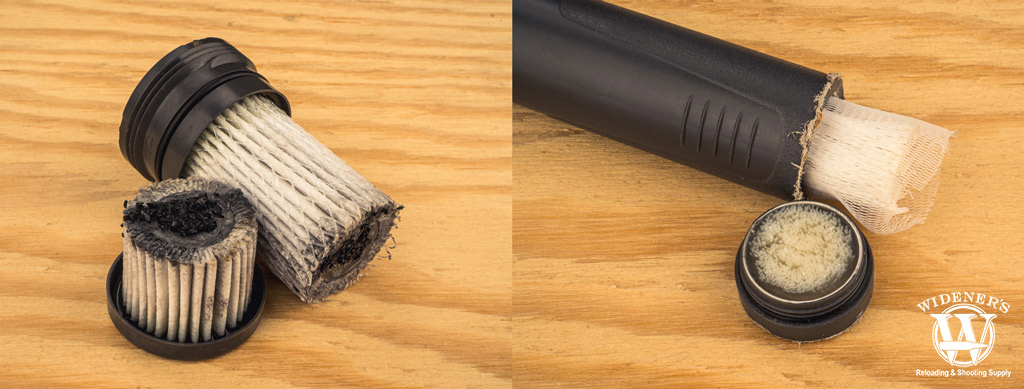
Not all water filters are made the same way, the Katadyn filter (Left) features a filter system with a carbon center, while the Aquaway filter (Right) features a filter system with a carbon filter on top.
There are many factors to consider when picking out the best water filter for your situation.
Number of people
The amount of people that will be relying on the water filter will determine the filter you use. A small bottle filter may be adequate for a single user, but is insufficient for a group of people. Gravity filters can filter water much quicker than other systems making it easy to provide water for multiple people.
Use type
If you’re planning to go on a week-long backpacking trip, you might need a different water filter than someone prepping for the unknown. Many backpackers are looking to lighten their load wherever they can and therefore may choose a much lighter filter than a prepper. You need to replace some filters after treating so many gallons. Preppers may specifically look for a filter with a longer filter life that they can keep next to their AR-15s and .223 ammunition stash for the end of the world as we know it.
Where you are going
You want to know what the water sources are like that you may be pulling water from. If water sources are scarce, you will need additional water storage. Water sources with a lot of silt and sediment may clog your filter. In that case, you will want to choose a filter with a good pre-filter. Also, consider backup options in case sediment clogs your filter.
Protection needed
You should research the area you’re traveling to in order to determine if there are any special water concerns. If you are traveling through a third world country, you may want to have a water purifier – a filter or treatment option that treats for bacteria, cysts/protozoa, and viruses. If you are traveling through the U.S. or Canada, a filter that only protects against bacteria and cysts/protozoa is probably fine.
You’ll want a filter that has verified its filtration abilities through an independent lab and NSF accreditation. For the most thorough protection, look for NSF/ANSI P231 or NSF P248.
Water For Survival

It may look clean and be from a natural source, but if you don’t know what’s in the water, having a quality water filter is a must.
A water filter is one of the most important pieces of survival equipment to have, whether you’re hiking or prepping for survival. It may be enticing to pick up the cheapest water filter or fall for the too-good-to-be-true claims. After these tests, it’s clear you can’t simply rely on marketing claims when your health is on the line.
After analyzing the results, there are several companies that seem to be on the “up and up”. However, it’s also clear that misleading and unsubstantiated claims are a problem in the filter world. It is our hope that this water filter test brings more awareness to the industry and makes these tricky waters easier to navigate as we head downstream.


